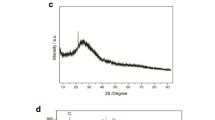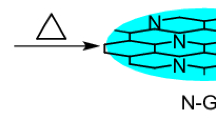Abstract
Quantum dots (QDs) and graphene oxide (GO) are extremely attractive and important nanomaterials in analytical applications because of their their unusual chemical, physical and electronic properties. In this work, CdTe QDs with the size of about 3 nm were prepared and a novel electrochemical sensing material of ascorbic acid on GO/CdTe QDs/GC electrode was explored. Transmission electron microscopy (TEM) was used to examine the morphological characterization of CdTe QDs and cyclic voltammetry (CV) and electrochemical impedance spectroscopy were used to perform the electrochemical investigations of the GO/CdTe QDs/GC electrode. Because of the synergy between the CdTe QDs and GO, this novel sensing based on CdTe QDs/GO/GC electrode responded even more sensitively and selectively than that based on bare GC electrode. Effects of pH value, buffer concentration, deposition potential and deposition time and electroactive interferents on the response of GO/CdTe QDs/GC electrode for ascorbic acid sensor were discussed. Under optimum working conditions, a linear response of the modified electrode was obtained over the concentration range of 32.3–500.0 µM with the detection limit of 6.1 µM for ascorbic acid. Finally, the inexpensive, reliable and sensitive modified electrode based on GO/CdTe QDs/GC was succesfully applied for the determination of ascorbic acid in citrus samples.
Similar content being viewed by others
References
Kalimuthu, P. and John, S.A., Electropolymerized film of functionalized thiadiazole on glassy carbon electrode for the simultaneous determination of ascorbic acid, dopamine and uric acid, Bioelectrochemistry, 2009, vol. 77, no. 1, pp. 13–18.
Padayatty, S.J., Katz, A., Wang, Y., Eck, P., Kwon, O., Lee, J.-H., Chen, S., Corpe, C., Dutta, A., Dutta, S.K., and Levine, M., Vitamin C as an antioxidant: evaluation of its role in disease prevention, J. Am. College Nutrition, 2003, vol. 22, no. 1, pp. 18–35.
Tian, X., Cheng, C., Yuan, H., Du, J., Xiao, D., Xie, S., and Choi, M.M.F., Simultaneous determination of l-ascorbic acid, dopamine and uric acid with gold nanoparticles-β-cyclodextrin-graphene-modified electrode by square wave voltammetry, Talanta, 2012, vol. 93, pp. 79–85.
Strohecker, R., Vitamin Assay Tested Methods, Weinhaim: Verlag Chemie, 1965.
British Pharmacopoeia Commision Secretariat, 2009.
Grotzkyj, G.M., Howland, K., Martin, C., and Bonner, A.B., A novel HPLC method for the concurrent analysis and quantitation of seven water-soluble vitamins in biological fluids (plasma and urine): a validation study and application, Sci. World J., 2012, vol. 2012, p. 8.
Kucukkolbasi, S., Bilber, O., Ayyildiz, H.F., and Kara, H., Simultaneous and accurate determination of water- and fat-soluble vitamins in multivitamin tablets by using an RP-HPLC method, Química Nova, 2013, vol. 36, pp. 1044–1051.
Özyürek, M., Güçlü, K., Bektaşoğlu, B., and Apak, R., Spectrophotometric determination of ascorbic acid by the modified CUPRAC method with extractive separation of flavonoids-La(III) complexes, Anal. Chim. Acta, 2007, vol. 588, no. 1, pp. 88–95.
Ball, G.F.M., Vitamin in Foods: Analysis Bioavailability and Stability, Taylor and Francis Group, 2006.
Pourmorad, F., Honary, S., Enayatifard, R., and Shahrbandi, S., Comparison between polarography and titrimetry methods for determination of ascorbic acid in pharmaceutical dosage forms, Boll Chim Farm, 2003, vol. 142, no. 7, pp. 295–297.
Kit-Anan, W., Olarnwanich, A., Sriprachuabwong, C., Karuwan, C., Tuantranont, A., Wisitsoraat, A., Srituravanich, W., and Pimpin, A., Disposable paper-based electrochemical sensor utilizing inkjet-printed polyaniline modified screen-printed carbon electrode for ascorbic acid detection, J. Electroanal. Chem., 2012, vol. 685, pp. 72–78.
Jurevičiūtė, I., Brazdžiuvienė, K., Bernotaitė, L., Šalkus, B., and Malinauskas, A., Polyaniline-modified electrode as an amperometric ascorbate sensor, Sens. Actuators B: Chem., 2005, vol. 107, no. 2, pp. 716–721.
Kong, Y., Shan, X., Ma, J., Chen, M., and Chen, Z., A novel voltammetric sensor for ascorbic acid based on molecularly imprinted poly(o-phenylenediamine-co-o-aminophenol), Anal. Chim. Acta, 2014, vol. 809, pp. 54–60.
Gao, Z., Siow, K.S., Ng, A., and Zhang, Y., Determination of ascorbic acid in a mixture of ascorbic acid and uric acid at a chemically modified electrode, Anal. Chim. Acta, 1997, vol. 343, no. 1, pp. 49–57.
Zhou, L., Gao, C., Xu, W., Wang, X., and Xu, Y., Enhanced biocompatibility and biostability of CdTe quantum dots by facile surface-initiated dendritic polymerization, Biomacromolecules, 2009, vol. 10, no. 7, pp. 1865–1874.
Xing, B., Li, W.-W., and Sun, K., A novel synthesis of high quality CdTe quantum dots with good thermal stability, Mater. Lett., 2008, vol. 62, no. 17, pp. 3178–3180.
Zaiats, G., Shapiro, A., Yanover, D., Kauffmann, Y., Sashchiuk, A., and Lifshitz, E., Optical and electronic properties of nonconcentric PbSe/CdSe colloidal quantum dots, J. Phys. Chem. Lett., 2015, vol. 6, no. 13, pp. 2444–2448.
Amelia, M., Lincheneau, C., Silvi, S., and Credi, A., Electrochemical properties of CdSe and CdTe quantum dots, Chem. Soc. Rev., 2012, vol. 41, no. 17, pp. 5728–5743.
Sobrova, P., Ryvolova, M., Hubalek, J., Adam, V., and Kizek, R., Voltammetry as a tool for characterization of CdTe quantum dots, Int. J. Molec. Sci.s, 2013, vol. 14, no. 7, p. 13497.
Baslak, C., Aslan, E., Patir, I.H., Kus, M., and Ersoz, M., Photocatalytic hydrogen evolution based on mercaptopropionic acid stabilized CdS and CdTeS quantum dots, Int. J. Hydrogen Energy, 2016, vol. 41, vol. 45, pp. 20523–20528.
Inamdar, S.N., Ingole, P.P., and Haram, S.K., Determination of band structure parameters and the quasiparticle gap of CdSe quantum dots by cyclic voltammetry, Chem. Phys. Chem., 2008, vol. 9, no. 17, pp. 2574–2579.
Pumera, M., Ambrosi, A., Bonanni, A., Chng, E.L.K., and Poh, H.L., Graphene for electrochemical sensing and biosensing, Trends Anal. Chem., 2010, vol. 29, no. 9, pp. 954–965.
Cai, W., Lai, T., Du, H., and Ye, J., Electrochemical determination of ascorbic acid, dopamine and uric acid based on an exfoliated graphite paper electrode: a high performance flexible sensor, Sens. Actuators B: Chem., 2014, vol. 193, pp. 492–500.
Han, Y., Zheng, J., and Dong, S., A novel nonenzymatic hydrogen peroxide sensor based on Ag-MnO2-MWCNTs nanocomposites, Electrochim. Acta, 2013, vol. 90, suppl. C, pp. 35–43.
Kim, Y.-R., Bong, S., Kang, Y.-J., Yang, Y., Mahajan, R.K., Kim, J.S., and Kim, H., Electrochemical detection of dopamine in the presence of ascorbic acid using graphene modified electrodes, Biosens. Bioelectron., 2010, vol. 25, no. 10, pp. 2366–2369.
Piven, N., Susha, A.S., Döblinger, M., and Rogach, A.L., Aqueous synthesis of alloyed CdSexTe1 − x nanocrystals, J. Phys. Chem. C, 2008, vol. 112, no. 39, pp. 15253–15259.
Baslak, C., Kus, M., Cengeloglu, Y., and Ersoz, M., A comparative study on fluorescence quenching of CdTe nanocrystals with a serial of polycyclic aromatic hydrocarbons, J. Luminescence, 2014, vol. 153, pp. 177–181.
Hummers, W.S. and Offeman, R.E., Preperation of graphitic oxide, J. Am. Chem. Soc., 1958, vol. 80, p. 1339.
Liang, W., Liu, S., Liu, Z., Li, D., Wang, L., Hao, C., and He, Y., Electron transfer and fluorescence “turnoff” based CdTe quantum dots for vancomycin detection at nanogram level in aqueous serum media, New J. Chem., 2015, vol. 39, no. 6, pp. 4774–4782.
Dalkiran, B., Erden, P.E., and Kilic, E., Graphene and tricobalt tetraoxide nanoparticles based biosensor for electrochemical glutamate sensing, Artificial Cells Nanomed. Biotechnol., 2017, vol. 45, no. 2, pp. 340–348.
Bijad, M., Karimi-Maleh, H., and Khalilzadeh, M.A., Application of ZnO/CNTs nanocomposite ionic liquid paste electrode as a sensitive voltammetric sensor for determination of ascorbic acid in food samples, Food Anal. Methods, 2013, vol. 6, no. 6, pp. 1639–1647.
Dalkiran, B., Kaçar, C., Erden, P.E., and Kiliç, E., Amperometric xanthine biosensors based on chitosan-Co3O4-multiwall carbon nanotube modified glassy carbon electrode, Sens. Actuators B: Chem., 2014, vol. 200, pp. 83–91.
Bard, A.J. and Faulkner, L.R., Electrochemical Methods: Fundamentals and Applications, New York: Wiley, 1980.
Asnaashariisfahani, M., Karimi-maleh, H., Ahmar, H., Ensafi, A.A., Fakhari, A.R., Khalilzadeh, M.A., and Karimi, F., Novel 8,9-dihydroxy-7-methyl-12H-ben-zothiazolo[2,3-b]quinazolin-12-one multiwalled carbon nanotubes paste electrode for simultaneous determination of ascorbic acid, acetaminophen and tryptophan, Anal. Methods, 2012, vol. 4, no. 10, pp. 3275–3282.
Cabrita, J.F., Ferreira, V.C., and Monteiro, O.C., Titanate nanofibers sensitized with nanocrystalline Bi2S3 as new electrocatalytic materials for ascorbic acid sensor applications, Electrochim. Acta, 2012, vol. 135, pp. 121–127. doi https://doi.org/10.1016/j.electacta.2014.04.135
Apetrei, I.M. and Apetrei, C., The biocomposite screen-printed biosensor based on immobilization of tyrosinase onto the carboxyl functionalised carbon nanotube for assaying tyramine in fish products, J. Food Eng., 2015, vol. 149, pp. 1–8.
Wang, C., Du, J., Wang, H., Zou Ce, Jiang, F., Yang, P., and Du, Y., A facile electrochemical sensor based on reduced graphene oxide and Au nanoplates modified glassy carbon electrode for simultaneous detection of ascorbic acid, dopamine and uric acid, Sens. Actuators B: Chem., 2014, vol. 204, pp. 302–309.
Gheibi, S., Karimi-Maleh, H., Khalilzadeh, M.A., and Bagheri, H., A new voltammetric sensor for electrocatalytic determination of vitamin C in fruit juices and fresh vegetable juice using modified multi-wall carbon nanotubes paste electrode, J. Food Sci. Technol., 2015, vol. 52, no. 1, pp. 276–284.
Karimi-Maleh, H., Moazampour, M., Yoosefian, M., Sanati, A.L., Tahernejad-Javazmi, F., and Mahani, M., An electrochemical nanosensor for simultaneous voltammetric determination of ascorbic acid and Sudan I in food samples, Food Anal. Methods, 2014, vol. 7, no. 10, pp. 2169–2176.
Liu, B., Luo, L., Ding, Y., Si, X., Wei, Y., Ouyang, X., and Xu, D., Differential pulse voltammetric determination of ascorbic acid in the presence of folic acid at electro-deposited NiO/graphene composite film modified electrode, Electrochim. Acta, 2014, vol. 142, pp. 336–342.
Gupta, V.K., Jain, A.K., and Shoora, S.K., Multiwall carbon nanotube modified glassy carbon electrode as voltammetric sensor for the simultaneous determination of ascorbic acid and caffeine, Electrochim. Acta, 2013, vol. 93, pp. 248–253.
Fernandes, D.M., Costa, M., Pereira, C., Bachiller-Baeza, B., Rodríguez-Ramos, I., Guerrero-Ruiz, A., and Freire, C., Novel electrochemical sensor based on N-doped carbon nanotubes and Fe3O4 nanoparticles: simultaneous voltammetric determination of ascorbic acid, dopamine and uric acid, J. Colloid Interface Sci., 2014, vol. 432, pp. 207–213.
Author information
Authors and Affiliations
Corresponding author
Additional information
The article is published in the original.
Rights and permissions
About this article
Cite this article
Kucukkolbasi, S., Erdogan, Z.O., Baslak, C. et al. A Highly Sensitive Ascorbic Acid Sensor Based on Graphene Oxide/CdTe Quantum Dots-Modified Glassy Carbon Electrode. Russ J Electrochem 55, 107–114 (2019). https://doi.org/10.1134/S1023193519010051
Received:
Revised:
Accepted:
Published:
Issue Date:
DOI: https://doi.org/10.1134/S1023193519010051




